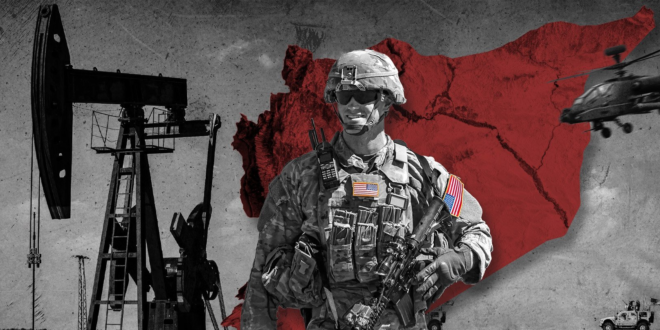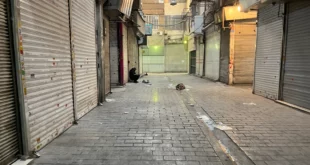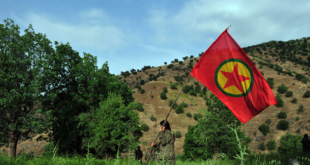While the world’s attention has been fixed on the brutalities of the Israeli occupation state, the illegal US military occupation of neighboring Syria has been largely neglected. Now, local and regional resistance is coalescing to target the American occupation head-on.
The strategic placement of US military bases in northeastern Syria is no coincidence. Extending from the Syrian–Jordanian–Iraqi border in the southwest of the country, to areas west of the Euphrates in the northeast, are 28 US installations – 24 of them US military bases.
This deployment, carefully planned out with specific geostrategic objectives, is there only to serve Washington’s local, regional, and international interests.
According to US data, the number of American occupation soldiers in Syria increased dramatically from 50 troops in 2015 to over 2,000 by the end of 2017. Reports in April 2017 even suggested that then-national security adviser Brigadier General HR McMaster considered deploying up to 50,000 troops to Iraq and Syria.
This substantial military buildup was justified by the Obama administration as necessary to address internal instability in Syria, including the rise of terrorism and the weakened state of government institutions. The US military presence capitalized on these conditions, exacerbated by foreign interventions that pumped weapons, cash, and intel to militant factions from the so-called ‘Free Syrian Army’ to extremist groups like the Al-Nusra Front and later ISIS.
The US also supported Kurdish forces in establishing an autonomous administration in Syria’s northeast, a move aimed at balancing Moscow’s influence after Damascus sought the intervention of Russia’s air force to help thwart the foreign-backed militancy.
Destabilization and economic blockade
One of the primary objectives of the illegal US presence is the looting of Syrian oil and gas resources. This not only funds the activities of their Kurdish-led Syrian Democratic Forces (SDF) proxies but also strengthens the economic blockade on Syria, exemplified by the Caesar Act sanctions imposed in June 2020.
At the time, former US envoy to Syria, James Jeffrey, stated that these sanctions contributed to the collapse of the Syrian pound and hindered the Syrian government’s economic policy, noting that Damascus “is incapable of managing an effective economic policy and conducting money-laundering in Lebanese banks.”
The US also uses oil revenues to finance its military presence and obstruct Syria’s reconstruction efforts. For instance, in August 2020, CNN reported on a deal approved by the Trump administration allowing US firm Delta Crescent Energy LLC to develop oil fields controlled by the SDF.
Containing Iran and securing Israeli interests
At the regional level, the US presence aims to prevent Iran from establishing land connections to the Mediterranean through Iraq and Syria. This strategic positioning also serves as a backup to the Incirlik Air Base in Turkiye amid growing tensions between Washington and Ankara.
Moreover, US bases in southeastern Syria and near the Iraqi border contain Arab tribes and protect Israel by blocking the land corridor between Syria and Iraq. Specifically, this move sought to isolate Syria from its regional allies, particularly Iran and Hezbollah, which pose a direct threat to Israel.
Countering Russian and Chinese influence
Internationally, the US presence in Syria helps Washington maintain its dominance over the global order, countering the influence of Eurasian powers Russia and China. The deployment in Syria is seen as a barrier to China’s Belt and Road initiative, which threatens to enhance Beijing’s economic growth in ways that could undermine US strategic positioning.
Despite the significant US presence, the long-term sustainability of American troops in hostile terrain is uncertain.
Washington’s efforts to change the Syrian political system have largely failed, and US bases and facilities have faced increasing attacks by regional resistance groups. Since November 2023, US soldiers and installations have faced 102 attacks, reflecting growing opposition to the American occupation of Syrian lands.
More recently, the success of Russian diplomacy and movements toward Syrian–Turkish reconciliation may force the US to choose between confrontation and withdrawal.
The future of US involvement in Syria
The upcoming US presidential election could also influence the future of American involvement in Syria. If the current administration manages to negotiate a regional ceasefire agreement – and declare serious interest in returning to the Iranian nuclear deal – it may opt to withdraw troops from Syria to bolster Democratic support. Conversely, if Donald Trump returns to power, a potential understanding with Russia could expedite the US exit from both Ukraine and Syria.
Since 2015, successive US administrations have failed to provide a clear, consistent number regarding the total American troop presence in Syria. However, estimates indicate that approximately 3,000 US soldiers are stationed across various bases in the governorates of Hasakah, Deir Ezzor, west of the Euphrates, and along the Syrian–Iraqi border.
The troop deployments form a strategic ‘ring’ around the region’s critical oil and gas resources, which constitute the bulk of Syria’s underground wealth. The concentration of US bases in these areas reveals their importance in securing energy resources and maintaining control over transportation routes for these products.
Securing Syria’s energy and sovereignty
The Rmeilan base, located in the northeastern countryside of Hasakah, was the first US military outpost in Syria. It houses around 500 personnel whose primary mission is safeguarding the region’s oil facilities. The area includes approximately 1,300 oil wells, producing between 120,000 and 150,000 barrels per day before 2011 and about two million cubic meters of gas.
Al-Shaddadi base, situated southeast of the city bearing the same name, is strategically positioned near the region’s most significant oil reserves. Within its vicinity is the Al-Gypsa field, which contains about 500 oil wells, making it the second-largest oil field in Al-Hasakah. The base also covers the Al-Shadadi gas plant, further emphasizing its critical role in controlling Syria’s energy resources.
The Al-Omari field base in Deir Ezzor is the largest and most crucial US base in Syria and is located in the Al-Omari oil field, which produced up to 80,000 barrels per day before 2011. This base, along with others like Conoco field, Tal Baydar, Life Stone, Qasrak, Himos, and Al-Tanf, ensures US dominance over the most vital and resource-rich terrain in Syria.
The US military presence in northeastern Syria is a strategic deployment with far-reaching implications. While it has served Washington’s aims to counter Iranian influence, secure Israeli interests, deplete Syria’s economy, and maintain US hegemony across the Levant and Persian Gulf, American troops are now facing the threat of daily strikes.
Resistance to the US presence currently comes from local Arab tribes and the region’s Resistance Axis, but wildly shifting regional dynamics and potential post-election changes in US foreign policy may expand opposition to these forces and eventually force a US withdrawal from Syria.
However, as long as the US continues to see value in its presence in the region, it is likely to maintain its military bases and pursue its strategic objectives in Syria for the foreseeable future.
 Eurasia Press & News
Eurasia Press & News




